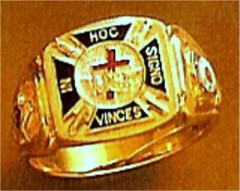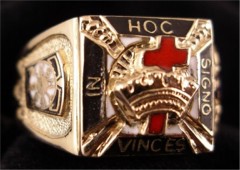Archive for the 'Freemasonry' Category
The Significance of the Masonic Ring
Of the many traditions and ceremonies associated with Freemasonry, most of them use unique objects which are bestowed with symbolic meaning by the Brotherhood. Masonic rings are very symbolic objects and perhaps the most common outward sign that its bearer is of The Craft. While most are worn on the right hand, previously Masonic rings were worn in secret, hiding the wearer’s identity from the public to protect their associations from detection. Historically speaking, a Freemason could be executed if he allowed his identity to be revealed.There are several styles of Masonic rings, most of which carry a crest or image which incorporates the square and compass motif. The square and compass designates common knowledge which is shared by Freemasons and is regarded as an Oath towards living a life of virtue and righteousness.
Knights Templar and Modern Banking
Although the primary mission of the Order was military, few participants in the Knights Templar were actually combatants. Most Knights Templar’s acted in support positions to assist the knights and to manage the financial infrastructure. The Templar Order, though its members were sworn to individual poverty, was given control of wealth beyond direct donations. A nobleman who was interested in participating in the Crusades might place all his assets under Templar management while he was away. Accumulating wealth in this manner, the Order in 1150 began generating letters of credit for pilgrims journeying to the Holy Land: pilgrims deposited their valuables with a local Templar preceptor before embarking, received a document indicating the value of their deposit, then used that document upon arrival in the Holy Land to retrieve their funds. This practice was an early form of banking, and may have been the first formal system to support the use of checks. This system improved the safety of those journeying to the Holy Land by making them less attractive targets for thieves, and also contributed immensely to the Templar coffers. They acquired large tracts of land, both in Europe and the Middle East; bought and managed farms and vineyards; built churches and castles; and were involved in manufacturing, import and export. The Templar’s had their own fleet of ships. Based on these kinds of donations and business dealings, the Templar’s established financial networks across much of Europe and the Middle East. An illustration of a Knights Templar Ring can be found amongst the many Masonic Rings illustrated at Fox Jewelry.
 The Knights Templar were the most powerful military order that played part in the Crusades. The Knights Templar were formed from several groups of knights for the express purpose of protecting Christian pilgrims in the Holy Land. The incorporation of these groups of knights created a powerful military force which formed the nucleus of the Crusading Army. The order adopted a monastic way of life based on that of St. Benedict. This dual identity brought about the famous description of them as “fiercer than lions and gentler than lambs.” The monastic life of the Knights Templar granted them the peace of mind and soul to fulfill their prescribed mission. The successes of the Knights Templar were numerous, especially in the Third Crusade. The Knights Templar fought fiercely against Saracen encroachment into territory held by the Latin Kingdoms of Palestine, but were driven into Cyprus when Acre fell in 1291. From Cyprus, the Knights Templar achieved financial success which in turn brought them the wrath of King Philip IV of France. The order was persecuted from 1308-1314 and destroyed with the death of the last Grandmaster, Jaques de Molay. An eaxample of a Knights Templar ring can be found at Fox Jewelry where many other Masonic rings can also be found.
The Knights Templar were the most powerful military order that played part in the Crusades. The Knights Templar were formed from several groups of knights for the express purpose of protecting Christian pilgrims in the Holy Land. The incorporation of these groups of knights created a powerful military force which formed the nucleus of the Crusading Army. The order adopted a monastic way of life based on that of St. Benedict. This dual identity brought about the famous description of them as “fiercer than lions and gentler than lambs.” The monastic life of the Knights Templar granted them the peace of mind and soul to fulfill their prescribed mission. The successes of the Knights Templar were numerous, especially in the Third Crusade. The Knights Templar fought fiercely against Saracen encroachment into territory held by the Latin Kingdoms of Palestine, but were driven into Cyprus when Acre fell in 1291. From Cyprus, the Knights Templar achieved financial success which in turn brought them the wrath of King Philip IV of France. The order was persecuted from 1308-1314 and destroyed with the death of the last Grandmaster, Jaques de Molay. An eaxample of a Knights Templar ring can be found at Fox Jewelry where many other Masonic rings can also be found.
 Although the primary mission of the Order was military, few members of the Knights Templar were actually combatants. Most Knights Templar’s acted in support positions to assist the knights and to manage the financial infrastructure. The Templar Order, though its members were sworn to individual poverty, was given control of wealth beyond direct donations. A nobleman who was interested in participating in the Crusades might place all his assets under Templar management while he was away. Accumulating wealth in this manner, the Order in 1150 began generating letters of credit for pilgrims journeying to the Holy Land: pilgrims deposited their valuables with a local Templar preceptor before embarking, received a document indicating the value of their deposit, then used that document upon arrival in the Holy Land to retrieve their funds. This practice was an early form of banking, and may have been the first formal system to support the use of checks. This system improved the safety of those journeying to the Holy Land by making them less attractive targets for thieves, and also contributed immensely to the Templar coffers. They acquired large tracts of land, both in Europe and the Middle East; bought and managed farms and vineyards; built churches and castles; and were involved in manufacturing, import and export. The Templar’s had their own fleet of ships. Based on these types of donations and business dealings, the Templar’s established financial networks across much of Europe and the Middle East. An example of a Knights Templar Ring can be found amongst the many Masonic Rings illustrated at Fox Jewelry.
Although the primary mission of the Order was military, few members of the Knights Templar were actually combatants. Most Knights Templar’s acted in support positions to assist the knights and to manage the financial infrastructure. The Templar Order, though its members were sworn to individual poverty, was given control of wealth beyond direct donations. A nobleman who was interested in participating in the Crusades might place all his assets under Templar management while he was away. Accumulating wealth in this manner, the Order in 1150 began generating letters of credit for pilgrims journeying to the Holy Land: pilgrims deposited their valuables with a local Templar preceptor before embarking, received a document indicating the value of their deposit, then used that document upon arrival in the Holy Land to retrieve their funds. This practice was an early form of banking, and may have been the first formal system to support the use of checks. This system improved the safety of those journeying to the Holy Land by making them less attractive targets for thieves, and also contributed immensely to the Templar coffers. They acquired large tracts of land, both in Europe and the Middle East; bought and managed farms and vineyards; built churches and castles; and were involved in manufacturing, import and export. The Templar’s had their own fleet of ships. Based on these types of donations and business dealings, the Templar’s established financial networks across much of Europe and the Middle East. An example of a Knights Templar Ring can be found amongst the many Masonic Rings illustrated at Fox Jewelry.
Fox Jewelry has some great alternatives to gold Masonic rings and other types of fraternal rings. Check out their selection of stainless steel masonic rings and sterling silver Masonic rings.
http://onlywire.com/r/67640975
Fox Jewelry has some great alternatives to gold Masonic rings and other types of fraternal rings. Check out their selection of stainless steel masonic rings and sterling silver Masonic rings.
http://onlywire.com/r/67640975